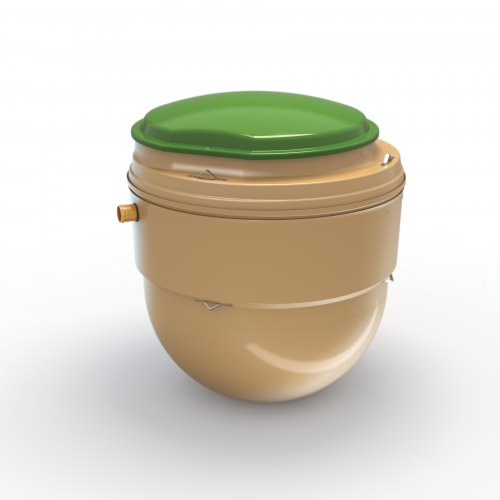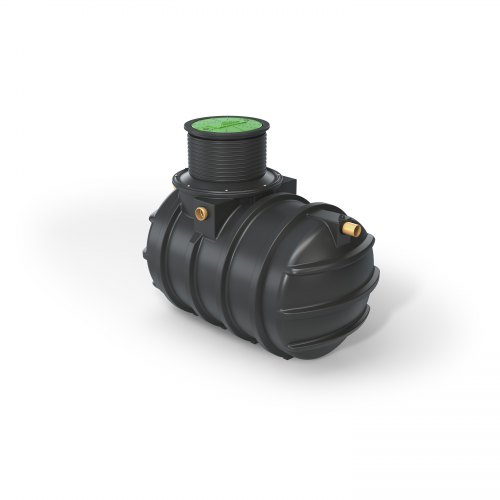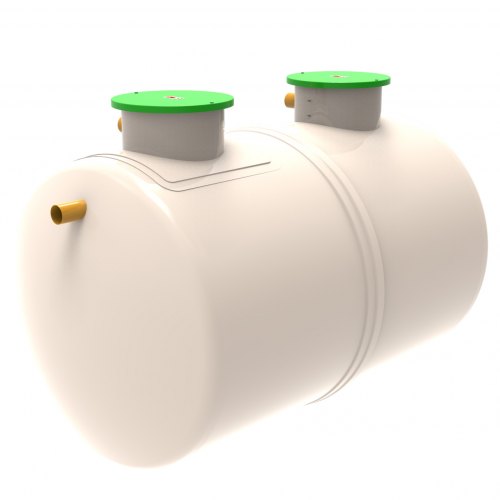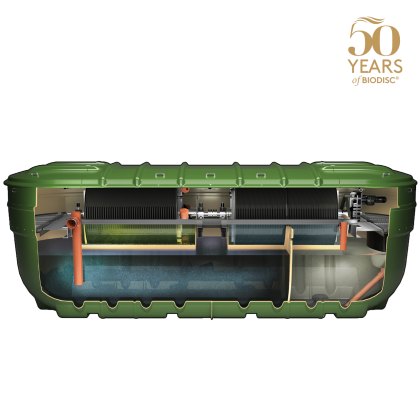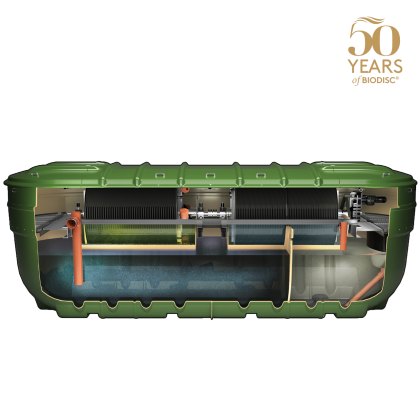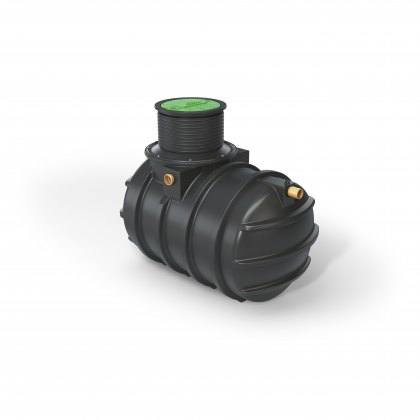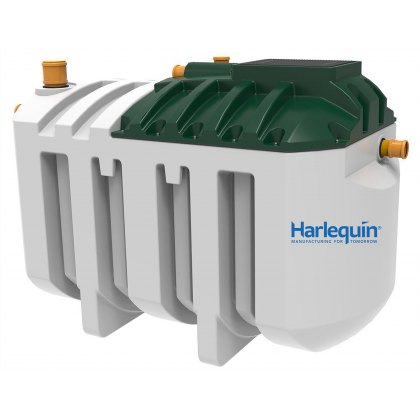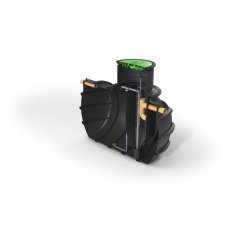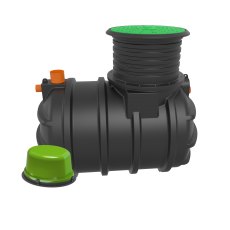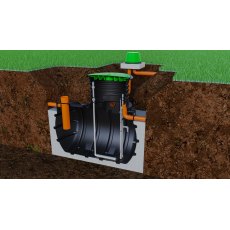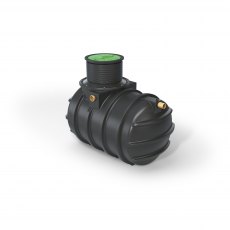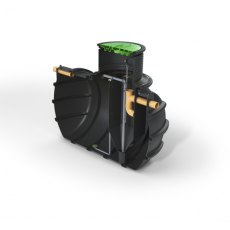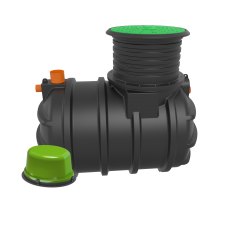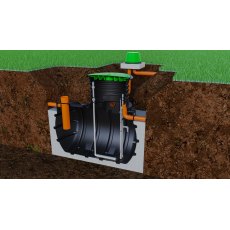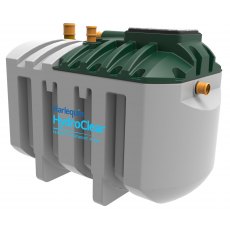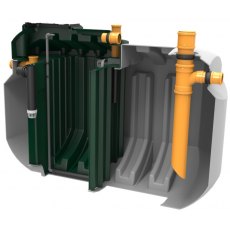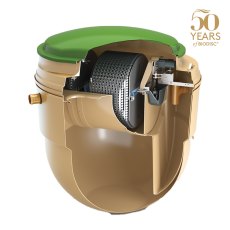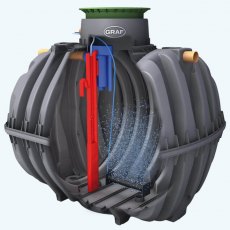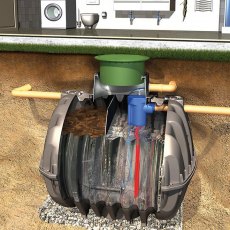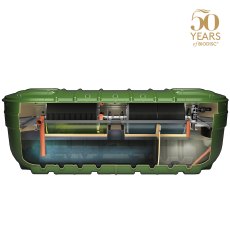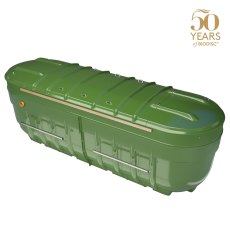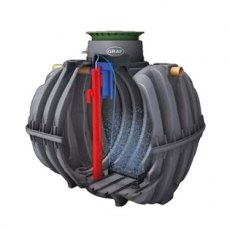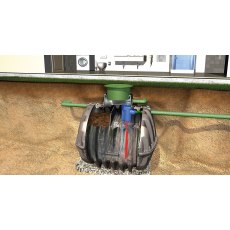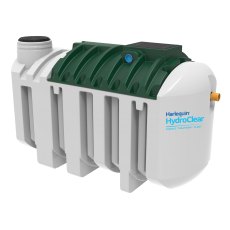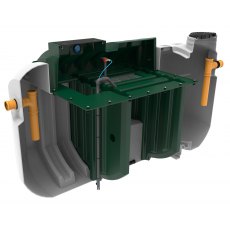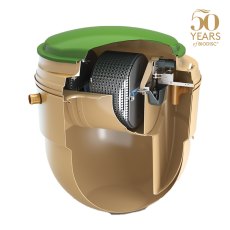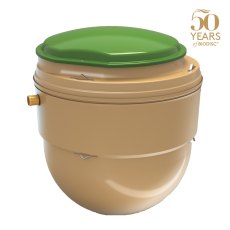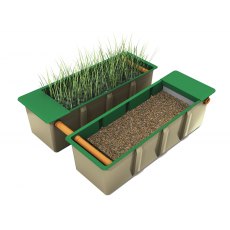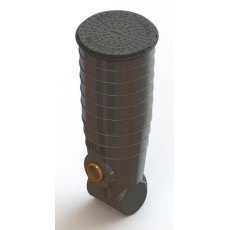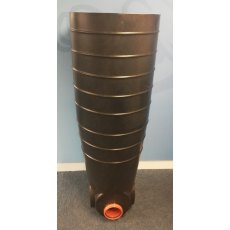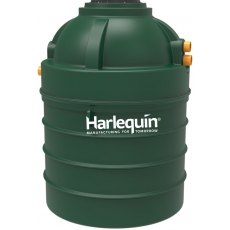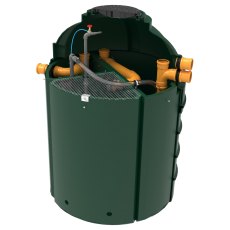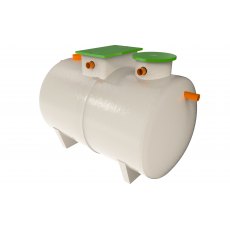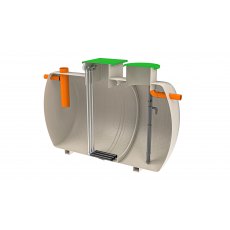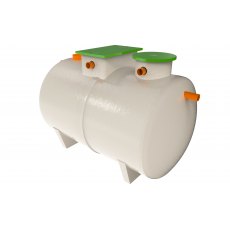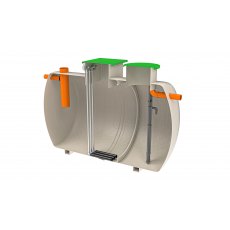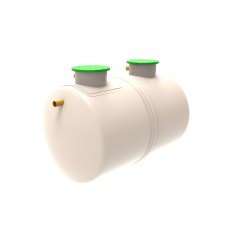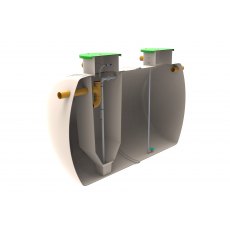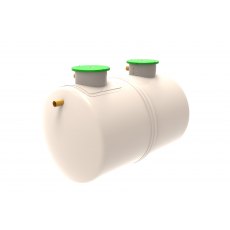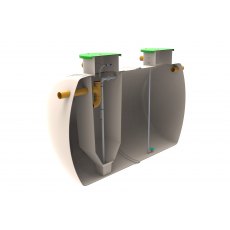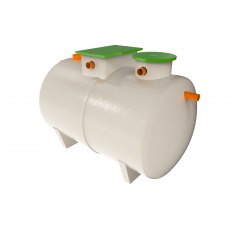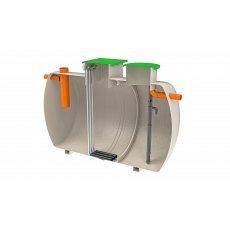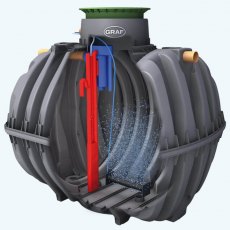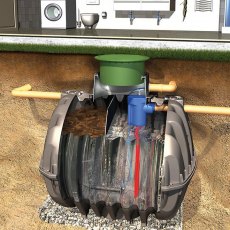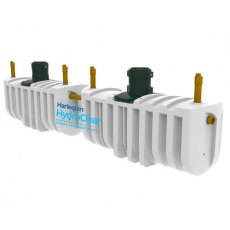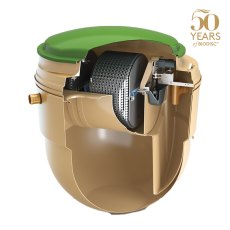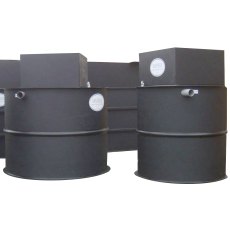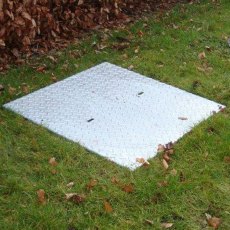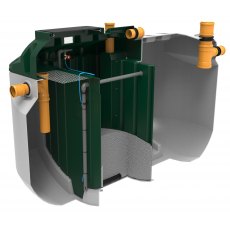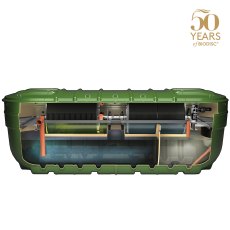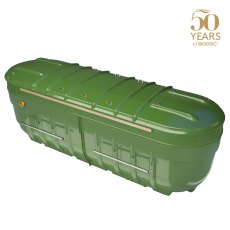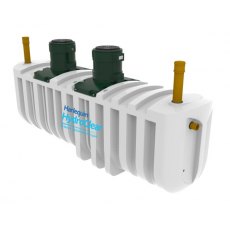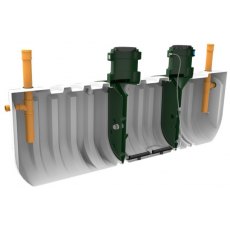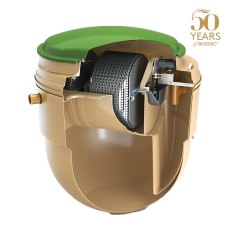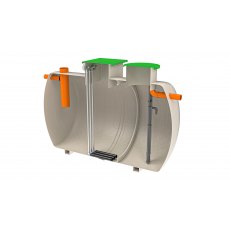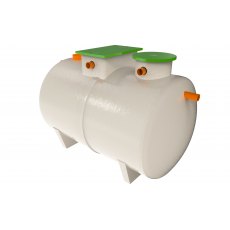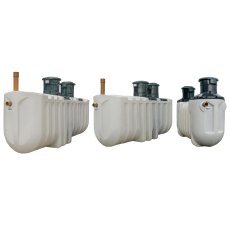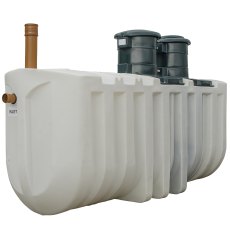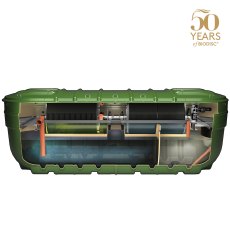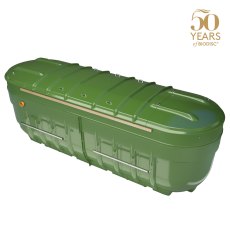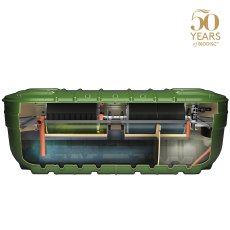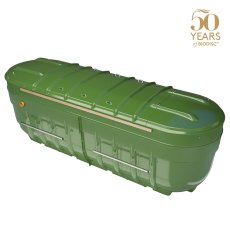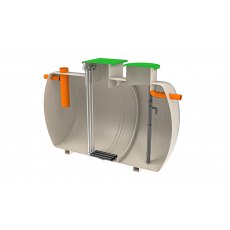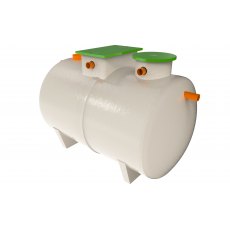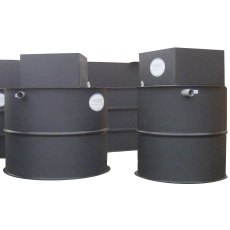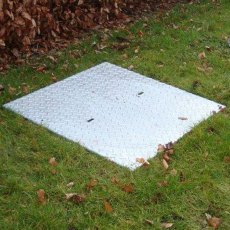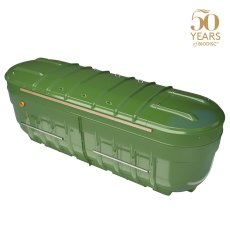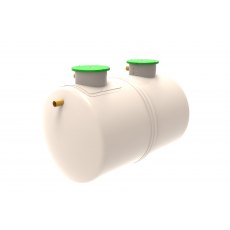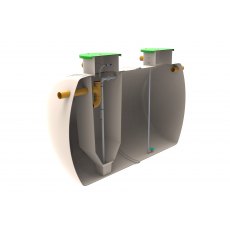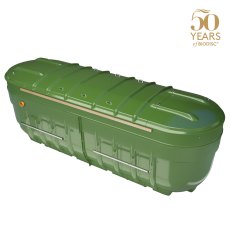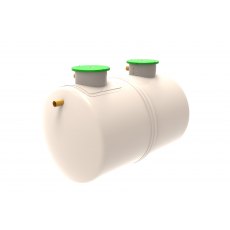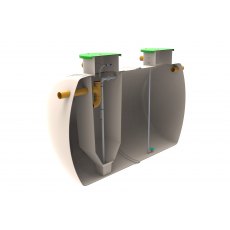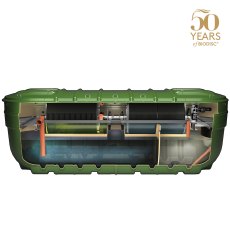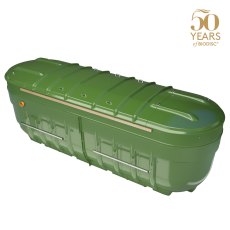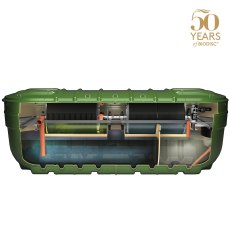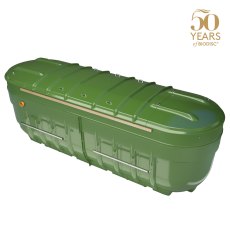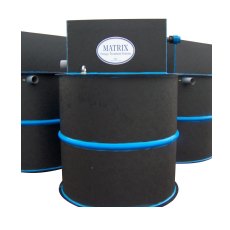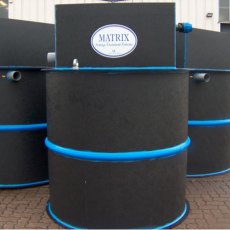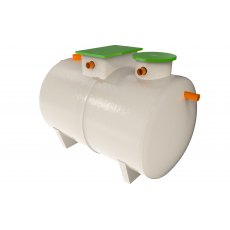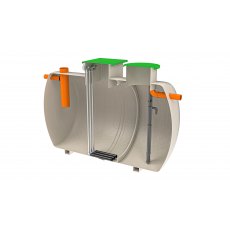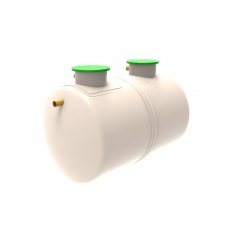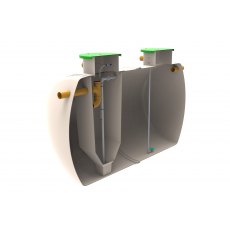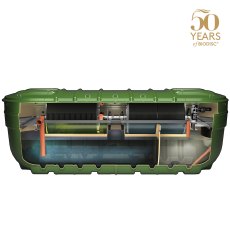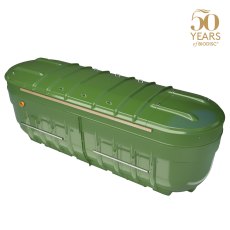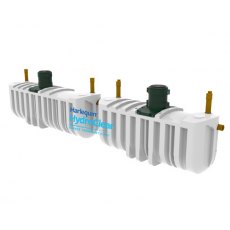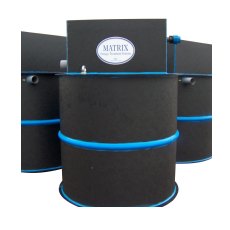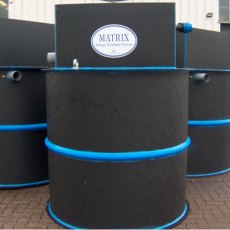Sewage Treatment Plant
What is a sewage treatment plant?
A domestic sewage plant is very similar, in its process, to a septic tank, by both separating solid and liquid waste. However, the sewage treatment plant is more advanced, as it treats the liquid waste and not just hold it. This in turn leads to higher quality effluent.
The first step of the unit's process is the collection of liquid waste from any toilets, sinks, baths, washing machines, and dishwashers. When it enters the treatment plant, it enters the 1st chamber, where the waste is separated out. The solids sink to the bottom of the tank.
The remaining liquid waste is channelled into chamber 2 - a specially engineered area of the tank, where the naturally occurring bacteria, begin to break the sewage down, all the while the motor is moving the water around, creating air, so the bacteria can eat and breed. The filtered liquid is clean enough, that it could be passed out of the unit into either a watercourse (e.g. a river or stream) or into a drainage field. (Please consult the environmental agency, to see if this is possible for your area).
Over time, the solids collected in chamber 1 will accumulate, resulting in the unit being cleared of the solid waste by a process called 'de-sludging'.
How Do Sewage Treatment Plants Work?
Sewage treatment systems work similarly to septic tanks, with sewage first flowing into the first chamber of the treatment plant. In this chamber, grease, oil, and scum will be separated onto the top of the tank, with the solids settling on the bottom. The liquids in this chamber are moved onto a second section, where air is pumped into it to grow the amount of aerobic bacteria in this sewage, which will break down the contaminants in the water. Once this water has been cleaned, this liquid moves onto a final settlement tank, where the few remaining solids are allowed to sink to the bottom of the tank before its contents are discharged into a soak away or watercourse.
We offer a wide variety of sewage treatment systems, including the industry-leading Klargester BioDisc, Klargester BioTec+, Harlequin Hydroclear and Clearwater BioAir CW Range. All of our sewage treatment plants meet or exceed all current legislation, including the General Binding Rules 2020. Tanks Direct offer a range of sewage systems including the Klargester BioDisc which is the only packaged sewage treatment plant that utilitises the Rotating Biological Contactor technology for small domestic applications. Learn more about how this product works with our comprehensive guide on sewage treatment plants here.
What are the key benefits of a sewage treatment plant?
The benefits of having a domestic sewage treatment plant installed are: -
- Environmentally friendly - the filtered water can be safely discharged into drainage fields, rivers, streams, and other bodies of water (if agreed with your local environment agency) without causing pollution or harming wildlife.
- Under the legislation of 2020, our sewage treatment plants are Legally compliant compared to the Septic tanks which are not, with regard to discharging into watercourses.
- Efficient and affordable running and maintenance costs. The Sewage treatment systems require little or no (dependent on the unit) electricity to run. They are efficient at breaking down the waste, reducing the risks of blockages.
- Long-lasting - a system like the Klargester BioDisc has a 7-year warranty* and has the potential to have a 20-year life cycle when looked after in accordance with the Manufacturers Guidance. (*T&Cs apply)
Preparing to install a sewage treatment plant?
There are a few things to consider before installing a new treatment plant, including: -
- Getting planning permission
- Building regulations approval
- Applying for a permit, if you do not meet the general building rules issued by the Environment Agency
To connect to a public foul sewer, you will need to be within 30 meters of the sewer, however, if you fall outside this, you may need a Sewage Treatment plant. If you're unsure of where your nearest public sewer is, you can either ask a neighbour or contact your local water authority.
How to maintain a sewage treatment plant?
With the right maintenance, a sewage treatment plant can last a long time without requiring any significant work. Some things you can do to help maintain your unit are listed below:
Check for Pollution
It is worth checking your sewage plant once a month for pollution, to do this you check the area in which the sewage is released for any signs of pollution. Depending on where you are releasing your effluent, depends on what thing to look out for. Some of the most common are:
- Releasing into a watercourse, check for sewage smells, overflowing sludge, or signs of scum or foam where you released the sewage.
- Releasing into the ground, check for sewage smells and any signs that your sewage isn’t draining properly.
Make sure you are ONLY disposing of appropriate waste via your toilets, sinks, and drains
All the below items can interfere with the working mechanisms and the natural ecosystem of the bacteria, resulting in more maintenance, if these items make their way into the system.
- Nappies, wet wipes, sanitary towels, and cotton buds
- Cooking oils and fats
- Strong chemicals like weed killer, insecticides, undiluted disinfectants, and bleaches, paint thinner, and turpentine.
Regular emptying (De-sludging)
Most manufacturers recommend that the tanks are emptied roughly once a year to keep sludge from building up, however, some low-budget options may need emptying more frequently per year.
Overall, a lack of maintenance can lead to additional costs to replace component parts and reduce the life of the unit that has been installed.
Still unsure if a Sewage plant is right for you
Check out the septic tank regulations
Sewage Treatment Plant FAQs
How does domestic sewage treatment work?
A domestic sewage treatment plant works by breaking down solid waste to produce a cleaner, more environmentally friendly effluent. Wastewater and sewage are supplied to the primary tank, where the solids separate and from the liquid and then flows into the biozone chamber. Here, a pump airs the waste and friendly bacteria is used to condense the organic matter, breaking it down. When the waste leaves the final waste chamber, it is 95% clean and ready for dispersal into soak away systems, subject to consent from the relevant environmental agency.
What are the environmental impacts of a sewage treatment plant?
A well-designed and properly maintained sewage treatment plant can have positive environmental impacts by reducing water pollution and protecting aquatic ecosystems. However, if not properly managed, a sewage treatment plant can also have negative impacts such as odours, noise pollution and emissions of greenhouse gases.
Domestic wastewater treatment plants use natural biological processes to break down sewage and safely process harmful compounds. This reduces pollution and is vital for protecting the local flora and fauna.
Maintained in accordance with the manufacturers recommendations, most modern treatment plants have a long lifespan and are a solid investment for any property. At Tanks Direct, we offer a range of affordable treatment plants to suit any budget, but the premium Klargester BioDisc offers significant benefits with no noise, no odour and up to 7 years warranty*.
How long do sewage treatment plants last?
Sewage treatment plants don’t require much upkeep, but it is important to keep them properly maintained and serviced. They will need emptying periodically, a process known as ‘desludging’, by a registered and licensed waste collection company. Treat your sewage treatment plant properly and it could last up to twenty years. If they are misused or not properly maintained, their lifespan will reduce significantly.
To keep your domestic sewage treatment plant working for as long as possible, pay attention to what you are flushing down the toilet and washing down the sink. Do not flush kitchen roll, food waste, nappies, baby wipes, grease, fats and oils or sanitary products down the drain and careful with the volume of cleaning agents and detergents you are using as these can sometimes overload the system. Areas with softer water will require weaker cleaning products than hard water areas. It’s also beneficial to get your sewage treatment plant regularly serviced, where a professional will come out and inspect your system and identify any potential issues before they get worse.
What is the difference between a septic tank and a sewage treatment plant?
Although the two are often mistaken as the same thing, there are some distinct differences between the two. A sewage treatment plant creates a clean, environmentally friendly effluent which can be discharged directly to a watercourse. They typically require electricity to operate and need regular servicing and emptying. A septic tank only requires emptying once a year, doesn’t use any electricity, and doesn’t require servicing. However, they produce a very polluting waste product, which must be dispersed to a soak away and the septic pollutants go through further handling by the natural aerobic soil bacteria.
Invert Depth, what is this?
It is the level of the soil pipe entering the septic tank or treatment system.
Gravity or IPS, what is the difference and when would I need them?
If the flow from your system can not release without help, i.e. required to be uplifted you would need a pump to help with this.
What are the 3 types of sewage treatment?
Primary wastewater treatment
The primary treatment of wastewater removes material that will either float to the top or settle to the bottom. The wastewater is temporarily held in a settling tank, where the heavier solids sink to the bottom and lighter bits float to the surface. Once settled, these solids are held back while the rest of the liquid is moved through to the secondary phase of wastewater treatment.
Secondary wastewater treatment
A deeper and more rigorous secondary phase of wastewater treatment uses aerobic biological processes to substantially degrade the biological content of the waste, reducing common biodegradable contaminants down to safe levels. There are three ways to do this: biofiltration that uses filters to ensure that any additional sediment is removed from the wastewater, aeration which increases oxygen saturation by introducing air to wastewater and oxidation ponds that allow wastewater to pass through natural bodies of water for a set period before being retained for two to three weeks.
Tertiary wastewater treatment
Tertiary wastewater treatment aims to improve water quality to meet domestic and industrial standards. It involves removing pathogens to ensure water is safe for drinking
What types of sewage treatment plants are available?
If you can’t connect to a public sewer, building regulations state you’ll need either a cesspool, septic tank or sewage treatment plant. At Tanks Direct, we offer a comprehensive choice from leading suppliers of waste water solutions such as Klargester, Rewatec, Harlequin or Clearwater.
Cesspools
A cesspool or cesspit is a sewage holding tank. The waste isn’t treated and there is no outlet (only vents to allow gas build-up to escape). Waste simply flows in to be stored and then, when the tank is full, a lorry tankers it away for disposal. A cesspool is a good option if the ground is unsuitable for waste to soak away or for sites that are close to drinking water supplies, as the waste is safely contained before being taken away.
Advantages of a cesspool:
- Cheap
- Low installation cost
- Low maintenance
Disadvantages of a cesspool:
- Sewage isn’t treated
- Requires regular emptying which can cost up to, £300 each time
Cesspools are banned in Scotland
Septic Tanks
Septic tanks can treat and discharge the liquid part of the sewage. Waste enters the first tank, where gravity separates the liquids from the solids. The liquid effluent flows out of the tank onto land, where it is cleaned as it percolates through the soil. Some sunken solids, or ‘sludge’, is broken down by natural bacteria, but the rest will need to be taken away by lorry. Septic tanks are suitable for single houses or small developments, but you’ll also need a drainage field that is porous enough to allow the waste to percolate through.
Advantages of a septic tank
- Relatively low installation cost
- Relatively low cost to run
- Only require emptying (or ‘desludging’) once or twice a year
Disadvantages of a septic tank
- Your ground must be porous enough to allow the liquid effluent to discharge
- New laws state septic tanks can no longer be discharged into a watercourse
Sewage Treatment Plants
Sewage treatment plants are suitable for everything - with small-scale, affordable domestic units available for single homes, to large-scale, commercial units available for large developments. They all work in the same way, creating an environment that allows helpful waste-degrading bacteria to flourish. Sewage treatment plants are the only option if you want to discharge your treated waste to a ditch or stream.
Advantages of a sewage treatment plants:
- Affordable
- Clean
- sewage treated to a higher standard so that it has minimal negative impact on the environment.
Disadvantages of a sewage treatment plants:
- Requires an electricity supply
- while the volume of solid matter is greatly reduced, it’ll still need pumping into a lorry for disposal.
- Require regular maintenance
Where would a sewage treatment plant be located on your premises?
All commercial sewage treatment plants must adhere to general binding rules, a set of stringent regulations laid out by local authorities to meet both environmental, health and safety concerns. General binding rules stipulate several requirements when it comes to the placement of any commercial sewage treatment plant. It should be positioned a minimum distance away from buildings and water sources, especially if your business is in a protected area. The distance will depend on the size and capacity of your sewage treatment plant. It is strongly recommended that you seek professional advice on making your commercial sewage treatment plant compliant.
Do I need planning permission to install a sewage treatment plant?
Depending on where you are in the UK, there are different rules relating to sewage treatment plants. You may need to apply for a Consent to Discharge licence from the Environment Agency, that says your wastewater is clean enough not to damage local wildlife. If you’re discharging less than 5,000 litres per day to surface water, you won’t need one.
You must apply for a permit:
- If you discharge more than 2,000 litres per day to the ground
- If you discharge to a well, borehole or other deep structure
- Where the tank is within an Environment Agency groundwater protection (SPZ) zone 1 (find out more at www.environment-agency.gov.uk).
If you are in any doubt whether you require a permit, check the government’s website here.
How do I need to prepare to install my sewage treatment plant?
It is highly recommended that you fully understand and adhere to all the regulations that will affect your installation and running of a sewage treatment plant. If you are the property owner where the tank is being installed, this is your sole responsibility, and you could be liable for heavy fines or repair costs if things are done incorrectly.
Do I need to empty my domestic sewage treatment plant?
Sewage treatment plants work by separating wastewater from solid waste in a settlement chamber. Gravity causes the heavier, solid waste to sink to the bottom of the tank so that the wastewater can be treated before being released into the environment. The solid at the bottom of the tank, referred to as sludge, builds up reducing the available volume and space in the tank for the wastewater treatment process. Your tank will become less effective and will eventually fail causing problems.
For this reason, your sewage treatment tank will need emptying periodically – a process known as desludging. How often you de-sludge your tank will depend on the type of system you have as sludge build up varies between systems. We recommend you use a registered and licensed waste collection company who will be fully insured to handle the sludge. They will visit your site, remove the sludge from your sewage treatment plant tank, and take it away for disposal.
Can I fit my own sewage treatment plant?
Although instructions are supplied with each of our products, installing a sewage treatment plant is no small feat and we do not recommend installing one yourself unless you are 100% confident you know what you’re doing. There are lots of health and safety issues to consider when excavating holes and if your sewage treatment plant is installed incorrectly you could find yourself in a nasty mess – both physically, financially, and legally.
Hiring a professional contractor to do the installation will give you complete peace of mind. Your sewage treatment plant will be installed safely, efficiently, and perhaps most importantly, it will be legally compliant. Be aware there are different rules relating to the installation of sewage treatment plants depending on whether you are based in England, Scotland, Wales, or Northern Ireland. You may need to apply for a Consent to Discharge from the Environment Agency – a licence that says that your wastewater is clean enough to release into the environment and not damage local wildlife.
How I do install a sewage treatment plant?
It is strongly recommended that a suitably trained and qualified professional installs your sewage treatment plant. You could be faced with hefty repair costs, fines and even legal issues (that will be far greater than the cost of hiring a professional installer) if any part of your private sewage system is installed incorrectly. If you are confident you have the skills to do this yourself, you should have step-by-step instructions on how to do it from the manufacturer of your chosen tank, plus all the health and safety measures that should be taken. The following will give you a brief guide on what will be involved in the installation, but always ensure you adhere to the manufacturer’s guidance as some steps may vary.
Inspect tank for damage
Although our tanks will have been fully tested and checked before being dispatched to you, make sure to thoroughly inspect the tank for any damage caused during transportation as, once the tank is installed, we may not be able to accept your return.
Placing the tank
Ensure your hole is large enough for the both the tank and the recommended backfill. Prepare a base for the tank and carefully lower the tank into the hole, using the recommended lifting system, checking that the inlet and outlet orientation is correct. Ensure your tank is level and use the correct backfill, which might be concrete, gravel or sand, but check the manufacturer’s manual to see what they advise and follow their steps for adding the backfill.
Installing the inlet and outlet
Installing the inlet and the outlet should be straightforward, but it is always worth contacting a qualified plumber if you are unsure. Follow the manufacturer’s installation guide to connect the pipework. For easier maintenance access, some manufacturers advise the installation of an inspection chamber before and after the treatment to make life easier should any problems arise in the future.
Wire up the electrics
All electrical work should be conducted by a qualified electrician. The installation manual will detail what is required.
This is a very simplistic guide of what is required to install your sewage treatment plant. In addition to these steps, you may also need to install a soak away to complete your system.
Do I need a soakaway for my sewage treatment plants?
A soakaway is a large hole dug into the ground, filled with stones, that manage the effluent and surface water by collecting, treating, and cleansing it, before letting it drain slowly back into the environment.
You do not necessarily need a soakaway for a sewage treatment plant – only for a septic tank. This is because the water released by a septic tank has only gone through one stage of treatment and is still hazardous to the environment. It is therefore important that water from a septic tank undergoes further treatment and cleansing in a soakaway before being safely released into the environment.
In a sewage treatment plant, the wastewater has already been through at least two stages of treatment and is therefore safe to be released directly back into the environment.
What is a soakaway?
A soakaway, also known as an infiltration system, is a type of drainage system used to manage surface water runoff. It consists of a pit or trench filled with gravel, stone, or other porous materials that allow water to percolate through them and into the ground.
Soakaways are typically used in areas where the soil has good drainage characteristics, and they are often used to manage water from roof gutters, surface water drains, or other impermeable surfaces. The idea is that the water is directed into the soakaway, where it slowly percolates into the surrounding soil, reducing the amount of runoff and preventing flooding.
How often do I need to service my treatment plant?
It is advisable to get the buildup of sludge in your system cleared and the mechanical and electronic components serviced every six to twelve months.
Do domestic sewage treatment plants smell?
A well-maintained sewage treatment plant should not give off any bad smells. They are designed to contain any naturally occurring odours that arise during the treatment process. If your sewage treatment plant has an unpleasant odour it is important to investigate the cause.
It could be that your tank is full and needs emptying. Check the levels of sludge in your tank and arrange for the tank to be emptied if necessary.
Clogged vents could also be the cause of odours. The vents in sewage treatment plants allow toxic and flammable methane gases present in the waste to escape. Check the vent isn’t clogged with waste, snow, ice, or an animal’s nest.
Bad smells can also be caused by contamination in your sewage treatment plant. Harsh chemicals, grease or fat will all interfere with the natural enzymes in your plant that work to break down the sewage.

 Login
Login